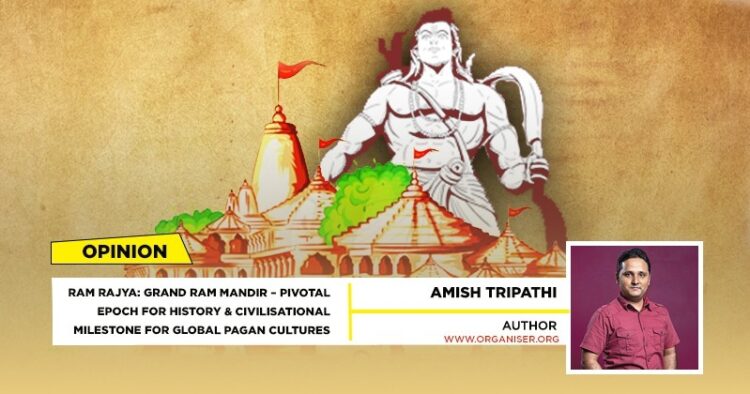I had visited Ram Lalla eight or nine years ago, when it was just a shed, and remember feeling very depressed. That time he was confined to a small area, and there was a tarpaulin, and one had to see him from a distance because of all the security and barricading. We, Hindus, see our deities as living beings –so their discomfort makes us very uncomfortable and helpless. Needless to say, it brings me so much joy and relief that Ram Lalla will find a suitable home now, and His bhakts will be able to access him and do Darshans and Sewa, befitting of Him. That time the priest recognised me because of my books, and we had a conversation about how helpless we felt, and now as the grand Mandir opens and the Shri Ram finally gets his place and seat, one is overwhelmed with emotions, difficult to describe in words.
While this is an emotional moment for all Ram Bhakts, Hindus, and Bharatiyas, at an intellectual level, it’s also a civilisational moment – one of great cultural and historical significance. For the first time in history, a pagan culture has reclaimed its symbol, after being wiped out. It’s a seminal moment not only for India but globally, for everyone.
Also, Shri Ram as a figure transcends Hindu Dharma and what we currently know as Bharat. Mentions of him in folk tales and cultural re-enactments are found all over Southeast Asia. You have to understand Ram to understand His appeal that sometimes cuts across regions and religions. Most of our deities stand for specific virtues. For instance, when one worships Krishna, one might imbibe qualities of love and vibrancy. When one worships Maa Shakti, she empowers to face life’s challenges. And when looks at Shri Ram—He stands for Ram Rajya—the ideal king and the ideal nation. Both these things are not absolute utopian states but works in progress. So, Shri Ram’s relevance cuts across genders and religions—He stands for Dharma. Unlike how most monarchies are run where the monarch does as he pleases, Bhagwan Ram showed how things should be, how one should put the family above oneself and the nation above family.
These qualities meant that kings across this region saw Him as an ideal to follow –many were named Ishvaku (another name for Shri Ram) through North and South of Bharatvarsh. His constant interaction with his people, considering their feedback, and his ability to put others before himself–were things that made him a supreme leader and a great example for people in power. So that in one quote in the Ramayan, Ravan says that if one were to have an enemy, it should be like Ram. He could’ve easily annexed Lanka after the war was won but His foreign policy wasn’t of infiltration and rule without consensus. Neither was He “turn the other cheek” kind of king. When triggered and wronged, He waged a war against Lanka and killed Ravan, but at the same time took into account the people of Lanka who appointed a leader from amongst them, and gave Ravan dignified last rites, befitting a king.
Such was Shri Ram’s grace, honour, humility, and greatness—making him a cultural and historical icon throughout South East Asia. January 22, 2024, should be a moment of celebration across the region.
Coming to two of the Shankaracharyas who are insisting that it’s being rushed and not following Vidhi Vidhaan, I would like to add that I respect the institution a lot, as I am a Shaivite, but don’t agree with their views entirely. My grandfather was a head priest in Varanasi, who had done Pran Pratishtha ceremonies during his lifetime. I belong to a family of pandits and have seen the rituals being carried out many times. In my understanding, the Garbh Griha (sanctum sanctorum) of the temple should be ready for the deity to be welcomed –which in this case is. The rest of the Mandir Parisar is a very elaborate complex with hospitals etc, which of course will take time. I don’t think that should hamper the advent of the deity. I think this has been mentioned even in the Agni Puraan, and in recent history, one has seen renovations being done at Somnath temple, while the Pran Pratishtha was done, once the Garbh Griha was ready.
Lastly, we should see this opportunity through the eyes of the millions who have been waiting for centuries for this moment, and do everything to celebrate it.




















Comments